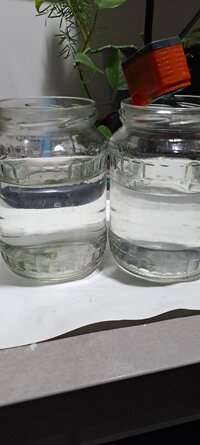It seems so trivial to test the equilibrium values. All you need is bicarbonate-buffered water and a good pH meter.
I set up a small experiment two days ago. Maybe the results are not too surprising, but still interesting.
So I set up two jars with water having dKH values of 10. I prepared the solution by dissolving 3g sodium bicarbonate in 500 ml RO water (resulting in 200 dKH, or 6g/l) and diluted it 20x (950 ml of RO water + 50 ml solution) to get 10 dKH (300 mg/l).
The right one has a small pump, which only ran for a few hours initially, but then it has been on for the last 12 hours. I planned to measure the pH every 30 minutes, but because of unforeseen events, I did not, and even the pump was turned off after a few hours. Then last evening, I turned on it again, and I measured the following pH values:
Starting pH values were ~ 7.40, which gives a CO2 value of ~11.9 ppm.
30 minutes:
left jar: pH 7.48 (9.9 ppm CO2)
right jar: pH 7.93 (3.5 ppm CO2)
24 h:
left jar: pH 8.05 (2.7 ppm CO2)
right jar: pH 8.37 (1.3 ppm CO2)
36 h:
left jar: pH 8.11 (2.3 ppm CO2)
right jar: pH 8.42 (1.1 ppm CO2)
I'll leave it for one more day and see what levels we go to.
From this, we can say that the lower the CO2 level is, the slower the gas exchange between water and air will be. Not a colossal surprise, but I didn't think the process was so slow.
Fick's law describes the diffusion rate, and one of the determining factors is the partial pressure difference between the two compartments. In the air, the partial pressure (pCO2) is around 0.0004 atm or 0.3 mmHg. If we take 0.5 ppm as the equilibrated CO2 concentration in water, my initial value of 11.9 ppm gives around 7 mmHg pCO2 in my tap water (from which the RO was produced). So I started with 6.7 mmHg driving force for gas exchange, which dropped in the left jar to 2.7 - 0.3 = 2.4 after 24h. In the same jar, it dropped 2 ppm in the first 30 minutes but only 0.4 ppm in the last 12 hours. It is not quite linearly proportional to the drop in the pCO2 difference. I think what complicates the situation here is the depth of the water column and that pCO2 is not equally distributed in the jar; probably, there is a gradient from bottom to top. The pCO2 gradient also drives the CO2 diffusion across the column. Still, I lack the mathematical skills to calculate how depth influences the gradient (and thus the degassing of the water) at different pCO2 levels.
One thing that can affect the results is that I had the jars in my house in the living room. With a quick search, google tells me that the CO2 range inside the house could be between 350 and 1000 ppm (because we produce CO2), so it might be that my right jar is very close to the equilibrium. I guess I will find it out my living room's CO2 levels after I get my samples closer to equilibration.
Anyways, I think the take-home message here could be that equilibration with air, especially if one is not moving the water, can be a slow process at low CO2 levels. One could wrongly conclude that the equilibrated values are around 3 ppm if leaves the water exposed to the air for only a day without agitation. I have made this mistake myself.
In an aquarium, degassing the produced CO2 might also be challenging at low CO2 levels, so it makes sense that the experienced concentrations in low-tech tanks indeed lay around 2-4 ppm.



